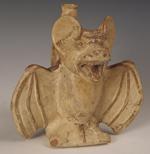Bat
| Bats Fossil range: 52–0 Ma Late Paleocene – Recent |
||||||||||||
|---|---|---|---|---|---|---|---|---|---|---|---|---|
 Townsend's big-eared bat, Corynorhinus townsendii
|
||||||||||||
| Scientific classification | ||||||||||||
|
||||||||||||
 |
||||||||||||
| Suborders | ||||||||||||
|
See article |
Bats are mammals in the order Chiroptera. The forelimbs of all bats are developed as wings, making them the only mammals naturally capable of flight (though other mammals, such as flying squirrels, flying possums and colugos, can glide for limited distances). The word Chiroptera comes from the Greek words cheir (χειρ) "hand" and pteron (πτερον) "wing," as the structure of the open wing is very similar to an outspread human hand with a membrane (patagium) between the fingers that also stretches between hand and body.
A measure of the success of bats is their estimated total of about 1,100 species worldwide, accounting for about 20 percent of all mammal species.[2] About 70 percent of bats are insectivores. Most of the rest are frugivores, with a few species being carnivorous. Bats are present throughout most of the world. Bats perform a vital ecological role by pollinating flowers, and also serve an important role in seed dispersal. Many tropical plants are entirely dependent on bats.
Bats range in size from Kitti's Hog-nosed Bat measuring 29–33 mm (1.14–1.30 in) in length and 2 g (0.07 oz) in mass,[3] to the Giant golden-crowned flying fox which has a wing span of 1.5 m (5 ft) and weighs approximately 1.2 kg (3 lb).
Contents[hide] |
Fossil bats
Since bats are terrestrial and light-boned, there are few fossilized remains. An Early Eocene bat, Onychonycteris finneyi, was found in the 52-million-year-old Green River Formation in Wyoming (US) in 2003. The new genus was placed in a new family when it was published in Nature, February 2008.[4] It was clearly a flier, but the well-articulated skeleton showed that the cochlea of the inner ear lacked the developments which, in modern bats, provide echolocation capabilities; this demonstrates that flight in bats was developed before echolocation. The team realized Onychonycteris finneyi was different when they noticed that the species lacked the ear and throat features present not only in all living, echolocating bats today, but also in other ancient species known only from fossils.
The bats of 52.5 million years ago flew differently than the bats of today, and had a vastly different appearance. Onychonycteris had claws on all five of its fingers, whereas modern bats have - at most - claws for only two digits on each hand. It also had longer hind legs, and shorter forearms, similar to those of climbing mammals that hang under branches (such as sloths or gibbons). This palm-sized animal had broad, short wings, which suggests that it could not fly as fast or as far as later bat species. Instead of flapping its wings continuously while flying, Onychonycteris would likely have alternated flapping and gliding while airborne. These physical characteristics also suggest that this species did not fly as much as modern bats do, perhaps just flying from tree to tree and spending most of its waking day just climbing or hanging.[5]
Another early Eocene fossil Icaronycteris index, was unearthed in 1960.
Classification and evolution
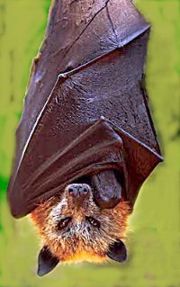
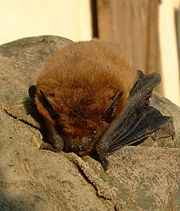
Bats are mammals. Though sometimes called "flying rodents", "flying rats," or even mistaken for insects and birds, bats are not, in fact, any of these things. There are two traditional suborders of bats:
- Megachiroptera (megabats)
- Microchiroptera (microbats/echolocating bats)
Despite the name, not all megabats are larger than microbats. The major distinction between the two suborders is based on other factors:
- Microbats use echolocation, whereas megabats do not (except for Rousettus and relatives).
- Microbats lack the claw at the second toe of the forelimb.
- The ears of microbats do not form a closed ring, but the edges are separated from each other at the base of the ear.
- Microbats lack underfur; they have only guard hairs or are naked.
Megabats eat fruit, nectar or pollen while microbats eat insects, blood (small quantities of the blood of animals), small mammals, and fish. While megabats have a well-developed visual cortex and show good visual acuity, microbats rely on echolocation for navigation and finding prey.
The phylogenetic relationships of the different groups of bats have been the subject of much debate. The traditional subdivision into Megachiroptera and Microchiroptera reflects the predominant view that suggests that these two groups of bats have evolved independently for a long time, from a common ancestor that was already capable of flight. This hypothesis recognizes the marked differences between microbats and megabats, while at the same time acknowledging the likelihood that flight has evolved only once in mammals. In addition, the majority of molecular biological evidence supports the point of view that bats form a monophyletic group[6].
More recently, researchers have proposed alternative views of chiropteran phylogeny (and classification), but more research is required to assess the merits of these proposals.
- Genetic evidence indicates that megabats should be placed within the four major lines of microbats, which originated during the early Eocene. This has resulted in a new classification, which includes two suborders. The suborder Yinpterochiroptera includes the Pteropodidae or megabat family as well as the Rhinolophidae, Megadermatidae, and Rhinopomatidae families. The Yangochiroptera includes all the remaining families of bats. Because these relationships combine echolocating and non-echolocating bats, it's unknown if the ancestor of bats possessed laryngeal echolocation and the bats of Pteropodiae subsequently lost it, or if this ability evolved twice.[7]
- As an alternative to the Yinpterochiroptera/Yangochiroptera classification, some researchers use Pteropodiformes and Vespertilioniformes as the names of suborders of chiroptera.[8][9] This nomenclature is said to have more long-term stability.[8] Under this new proposed nomenclature, the suborder Pteropodiformes would be defined to include all extant bat families more closely related to the genus Pteropus than to the genus Vespertilio, while the suborder Vespertilioniformes would be defined to include all extant bat families more closely related to the genus Vespertilio than to the genus Pteropus.
- In the 1980s, it was hypothesized based on morphological evidence that Megachiroptera evolved flight separately from Microchiroptera. The so-called Flying primates theory proposed that when adaptations to flight are discounted in a cladistic analysis, the Megachiroptera are allied to primates by anatomical features that are not shared with Microchiroptera. For example, the brains of megabats show a number of advanced characteristics linking these animals to primates. Although recent genetic studies support the monophyly of bats[10], debate persists about the relative merits of DNA versus morphological evidence in settling this controversy.
Little fossil evidence exists about the evolution of bats, since their small, delicate skeletons do not fossilize well. However a Late Cretaceous tooth from South America resembles that of an early Microchiropteran bat. The oldest known definite bat fossils, such as Icaronycteris, Archaeonycteris, Palaeochiropteryx and Hassianycteris, are from the early Eocene ([6]), but they were already very similar to modern microbats. Archaeopteropus, formerly classified as the earliest known megachiropteran, is now classified as a microchiropteran.
Bats were formerly grouped in the superorder Archonta along with the treeshrews (Scandentia), colugos (Dermoptera), and the primates, because of the similarities between Megachiroptera and these mammals. However, genetic studies have now placed bats in the superorder Laurasiatheria along with carnivorans, pangolins, odd-toed ungulates, even-toed ungulates, and cetaceans.

Below is the traditional classification of bats.
- Order Chiroptera (Ky-rop`ter-a) (Gr. cheir, hand, + pteron, wing)
- Suborder Megachiroptera (megabats)
- Suborder Microchiroptera (microbats)
- Superfamily Emballonuroidea
- Emballonuridae (Sac-winged or Sheath-tailed bats)
- Superfamily Molossoidea
- Antrozoidae (Pallid bats)
- Molossidae (Free-tailed bats)
- Superfamily Nataloidea
- Furipteridae (Smoky bats)
- Myzopodidae (Sucker-footed bats)
- Natalidae (Funnel-eared bats)
- Thyropteridae (Disk-winged bats)
- Superfamily Noctilionoidea
- Mormoopidae (Ghost-faced or Moustached bats)
- Mystacinidae (New Zealand short-tailed bats)
- Noctilionidae (Bulldog bats or Fisherman bats)
- Phyllostomidae (Leaf-nosed bats)
- Superfamily Rhinolophoidea
- Megadermatidae (False vampires)
- Nycteridae (Hollow-faced or Slit-faced bats)
- Rhinolophidae (Horseshoe bats)
- Superfamily Rhinopomatoidea
- Craseonycteridae (Bumblebee Bat or Kitti's Hog-nosed Bat)
- Rhinopomatidae (Mouse-tailed bats)
- Superfamily Vespertilionoidea
- Vespertilionidae (Vesper bats or Evening bats)
- Superfamily Emballonuroidea
Megabats are primarily fruit- or nectar-eating. They have probably evolved for some time in New Guinea without microbat concurrention. This has resulted in some smaller megabats of the genus Nyctimene becoming (partly) insectivorous to fill the vacant microbat ecological niche. Furthermore, there is some evidence that the fruit bat genus Pteralopex from the Solomon Islands, and its close relative Mirimiri from Fiji, have evolved to fill some niches that were open because there are no nonvolant (non-flying) mammals in those islands.
Anatomy
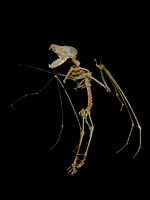
By emitting high-pitched sounds and listening to the echoes, also known as sonar, microbats locate prey and other nearby objects. This is the process of echolocation, an ability they share with dolphins and whales. Two groups of moths exploit the bats' senses: tiger moths produce ultrasonic signals to warn the bats that the moths are chemically-protected (aposematism) (this was once thought to be a form of "radar jamming", but this theory has been disproved); the moths Noctuidae have a hearing organ called a tympanum which responds to an incoming bat signal by causing the moth's flight muscles to twitch erratically, sending the moth into random evasive manoeuvres.
Although the eyes of most microbat species are small and poorly developed, leading to poor visual acuity, it is incorrect to assume that they are nearly blind. Vision is used as an aid in navigation especially at long distances, beyond the range of echolocation. It has even been discovered that some species are able to detect ultraviolet light. Their senses of smell and hearing are excellent.
The teeth of microbats resemble those of the insectivorans. They are very sharp in order to bite through the hardened armor of insects or the skin of fruit.
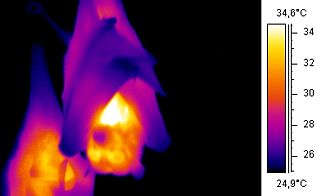
While other mammals have one-way valves only in their veins to prevent the blood from flowing backwards, bats also have the same mechanism in their arteries.
The finger bones of bats are much more flexible than those of other mammals. One reason is that the cartilage in their fingers lacks calcium and other minerals nearer the tips, increasing their ability to bend without splintering. The cross-section of the finger bone is also flattened instead of circular as is the bone in a human finger, making it even more flexible. The skin on their wing membranes is a lot more elastic and can stretch much more than is usually seen among mammals.
Because their wings are much thinner than those of birds, bats can maneuver more quickly and more precisely than birds. The surface of their wings are also equipped with touch-sensitive receptors on small bumps called Merkel cells, found in most mammals, including humans. But these sensitive areas are different in bats as each bump has a tiny hair in the center,[11] making it even more sensitive, and allowing the bat to detect and collect information about the air flowing over its wings. An additional kind of receptor cell is found in the wing membrane of species that use their wings to catch prey. This receptor cell is sensitive to the stretching of the membrane.[11] The cells are concentrated in areas of the membrane where insects hit the wings when the bats capture them.
One species of bat has the longest tongue of any mammal relative to its body size. This is beneficial to them in terms of pollination and feeding - their long narrow tongues can reach deep into the long cup shape of some flowers. When their tongue retracts, it coils up inside their rib cage.[12]
The lungs of bats are typical mammalian lungs, and unlike the lungs of birds; this has been hypothesized to make them more sensitive to rupture when subjected to the sudden changes in air pressure generated in the immediate neighbood of wind turbines, and therefore explain their apparent higher rate of mortality associated with these mechanisms.[13]
Reproduction
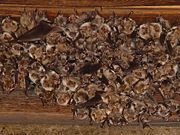
Mother bats usually have only one offspring per year, and they are viviparous. A baby bat is referred to as a pup.[14] Pups are usually left in the roost when they are not nursing. However, a newborn bat can cling to the fur of the mother and be transported, although they soon grow too large for this. It would be difficult for an adult bat to carry more than one young, but normally only one young is born. Bats often form nursery roosts, with many females giving birth in the same area, be it a cave, a tree hole, or a cavity in a building. Mother bats are able to find their young in colonies of millions of pups. Pups have even been seen to feed on other mothers' milk if their mother is dry. Only the mother cares for the young, and there is no continuous partnership with male bats.
The ability to fly is congenital, but at birth the wings are too small to fly. Young microbats become independent at the age of 6 to 8 weeks, megabats not until they are four months old. At the age of two years, bats are sexually mature.
A single bat can live over 20 years, but the bat population growth is limited by the slow birth rate.[15]
Behavior
Most microbats are active at night or at twilight.
Many bats migrate[16], while others pass into torpor in cold weather but rouse themselves and feed when warm spells permit insect activity[17]. Yet others retreat to caves for winter and hibernate for six months[17]. Bats rarely fly in rain- the rain interferes with their echo location, and they are unable to locate their food.
The social structure of bats varies, with some bats leading a solitary life and others living in caves colonized by more than a million bats[18]. The fission-fusion social structure is seen among several species of bats. "Fusion" refers to the grouping of large numbers of bats in one roosting area and "fission" is the breaking apart and mixing of subgroups, with individual bats switching roosts with others and often ending up in different trees and with different roostmates.
Studies also show that bats make all kinds of sounds to communicate with others. Scientists in the field have listened to bats and have been able to identify some sounds with some behaviour bats will make right after the sounds are made[18].
70% of bat species are insectivorous, locating their prey by means of sonar. Of the remainder, most feed on fruits and their juices[19]. Only three species sustain themselves with blood. Some species even prey on vertebrates: these are the leaf-nosed bats (Phyllostomidae) of Central America and South America, and the two bulldog bat (Noctilionidae) species, which feed on fish. At least two species of bat are known to feed on other bats: the Spectral Bat, also called the American False Vampire bat, and the Ghost Bat of Australia[19]. One species, the Greater Noctule bat, is believed to catch and eat small birds in the air.
It has been noted recently that, unexpectedly, bats seem to suffer a higher death rate than birds in the neighborhood of wind turbines[20], [21], [22] ; since there are no signs of external trauma, the cause has been hypothesized to be a greater sensitivity to sudden pressure fluctuations in the mammalian lung than in that of birds.[23] In addition, it has been suggested that bats are attracted to these structures, perhaps seeking roosts, and thereby increasing the death rate.[13]
As vectors for pathogens
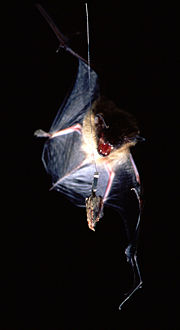
Bats are natural reservoirs or vectors for a large number of zoonotic pathogens[24] including rabies,[25] severe acute respiratory syndrome (SARS),[26] Henipavirus (ie. Nipah virus and Hendra virus)[27] and possibly ebola virus[28].[29] Their high mobility, broad distribution, and social behaviour (communal roosting, fission-fusion social structure) make bats favourable hosts and vectors of disease. Many species also appear to have a high tolerance for harbouring pathogens and often do not develop disease while infected.
Only 0.5% of bats carry rabies. However, of the few cases of rabies reported in the United States every year, most are caused by bat bites.[30] Although most bats do not have rabies, those that do may be clumsy, disoriented, and unable to fly, which makes it more likely that they will come into contact with humans. Although one should not have an unreasonable fear of bats, one should avoid handling them or having them in one's living space, as with any wild animal. If a bat is found in living quarters near a child, mentally handicapped person, intoxicated person, sleeping person, or pet, the person or pet should receive immediate medical attention for rabies. Bats have very small teeth and can bite a sleeping person without being felt. There is evidence that it is possible for the bat rabies virus to infect victims purely through airborne transmission, without direct physical contact of the victim with the bat itself.[31][32]
If a bat is found in a house and the possibility of exposure cannot be ruled out, the bat should be sequestered and an animal control officer called immediately, so that the bat can be analysed. This also applies if the bat is found dead. If it is certain that nobody has been exposed to the bat, it should be removed from the house. The best way to do this is to close all the doors and windows to the room except one to the outside. The bat should soon leave.
Due to the risk of rabies and also due to health problems related to their faecal droppings (guano), bats should be excluded from inhabited parts of houses. The Center for Disease Control and Prevention provides full detailed information on all aspects of bat management, including how to capture a bat, what to do in case of exposure, and how to bat-proof a house humanely.[33] In certain countries, such as the United Kingdom, it is illegal to handle bats without a license.
Where rabies is not endemic, as throughout most of Western Europe, small bats can be considered harmless. Larger bats can give a nasty bite. They should be treated with the respect due to any wild animal.
Cultural aspects
The bat is sacred in Tonga and West Africa and is often considered the physical manifestation of a separable soul . Bats are closely associated with vampires, who are said to be able to shapeshift into bats, fog, or wolves. Bats are also a symbol of ghosts, death, and disease. Among some Native Americans, such as the Creek, Cherokee and Apache, the bat is a trickster spirit. Chinese lore claims the bat is a symbol of longevity and happiness, and is similarly lucky in Poland and geographical Macedonia and among the Kwakiutl and Arabs. The bat is also a heraldic animal of the Spanish autonomous community of Valencia.
Pre-Columbian cultures associated animals with gods and often displayed them in art. The Moche people depicted bats in their ceramics.[34]
In Western Culture, the bat is often a symbol of the night and its foreboding nature. The bat is a primary animal associated with fictional characters of the night, both villains like Dracula and heroes like Batman. The association of the fear of the night with the animal was treated as a literary challenge by Kenneth Oppel, who created a best selling series of novels, beginning with Silverwing, which feature bats as the central heroic figures much as anthropomorphized rabbits were the central figures to the classic novel Watership Down.
An old wives' tale has it that bats will entangle themselves in people's hair. One likely source of this belief is that insect-eating bats seeking prey may dive erratically toward people, who attract mosquitoes and gnats, leading the squeamish to believe that the bats are trying to get in their hair.
In the United Kingdom all bats are protected under the Wildlife and Countryside Acts, and even disturbing a bat or its roost can be punished with a heavy fine.
In Sarawak, Malaysia bats are protected species under the Wildlife Protection Ordinance 1998 (see Malaysian Wildlife Law). The large Naked bat (see Mammals of Borneo) and Greater Nectar bat are consumed by the local communities.
Bats can be a tourist attraction. The Congress Avenue bridge in Austin, Texas is the summer home to North America's largest urban bat colony, an estimated 1,500,000 Mexican free-tailed bats, which eat an estimated 10,000 to 30,000 pounds of insects each night. An estimated 100,000 tourists per year visit the bridge at twilight to watch the bats leave the roost.

Artificial roosts
Many people put up bat houses to attract bats just like many people put up birdhouses to attract birds. Reasons for this vary, but mostly center around the fact that bats are the primary nocturnal insectivores in most if not all ecologies. Bat houses can be made from scratch, made from kits, or bought ready made. Plans for bat houses exist on many web sites, as well as guidelines for designing a bat house[35]. Some conservation societies are giving away free bat houses to bat enthusiasts worldwide.
A bat house constructed in 1991 at the University of Florida campus next to Lake Alice in Gainesville has a population of over 100,000 free-tailed bats.[36]
In Britain, pillboxes dating from World War II have been converted to make roosts for bats. Pillboxes that are well dug-in and thick walled are naturally damp and provide a stable thermal environment that is required by bats that would otherwise hibernate in caves. With a few minor modifications, suitable pillboxes can be converted to artificial caves for bats.[37][38]
See also
- Agreement on the Conservation of Populations of European Bats (UNEP/EUROBATS)
- Audiograms in mammals
- Bat bomb
- Bat boy
- Bat species
- Bat detector
- Bat World Sanctuary
- Batman
- European Bat Night
- Fictional bats
- Flying and gliding animals
- White nose syndrome
References
- ↑ Eick et al. (2005). "A Nuclear DNA Phylogenetic Perspective on the Evolution of Echolocation and Historical Biogeography of Extant Bats (Chiroptera)". Molecular Biology and Evolution 22: 1869. doi:. PMID 15930153. "Several molecular studies have shown that Chiroptera belong to the Laurasiatheria (represented by carnivores, pangolins, cetartiodactyls, eulipotyphlans, and perissodactyls) and are only distantly related to dermopterans, scandentians, and primates (Nikaido et al. 2000; Lin and Penny 2001; Madsen et al. 2001; Murphy et al. 2001a, 2001b; Van Den Bussche and Hoofer 2004).".
- ↑ Tudge, Colin (2000). The Variety of Life. Oxford University Press. ISBN 0-19-860426-2.
- ↑ "Bumblebee bat (Craseonycteris thonglongyai)". EDGE Species. Retrieved on 2008-04-10.
- ↑ (BBC News) "Bat fossil solves evolution poser" 13 February 2008.
- ↑ (Discovery Channel article) "Prehistoric bats learned to fly before they could see"February 13, 2008.
- ↑ 6.0 6.1 Nancy B. Simmons1, Kevin L. Seymour2, Jo¨rg Habersetzer3 & Gregg F. Gunnell4 (2008). "Primitive Early Eocene bat from Wyoming and the evolution of flight and echolocation". Nature 451: 818. doi:.
- ↑ "[http://animaldiversity.ummz.umich.edu/site/accounts/information/Chiroptera.html Order Chiroptera bats]". http://animaldiversity.ummz.umich.edu/site/index.html.+Retrieved on 2007-12-30.
- ↑ 8.0 8.1 James M. Hutcheon and John A.W. Kirsch. "A moveable face: deconstructing the Microchiroptera and a new classification of extant bats" (PDF). doi:10.3161/1733-5329(2006)8%5B1:AMFDTM%5D2.0.CO;2.
- ↑ Eick et al. (2005). "A Nuclear DNA Phylogenetic Perspective on the Evolution of Echolocation and Historical Biogeography of Extant Bats (Chiroptera)". Molecular Biology and Evolution 22: 1869. doi:. PMID 15930153. "Following the recommendations of Hutcheon and Kirsch (2004), we refer to the two suborders of chiropterans as ‘Pteropodiformes’ (comprising the Pteropodidae, Rhinolophidae, Hipposideridae, Megadermatidae, and Rhinopomatidae) and ‘Vespertilioniformes’ (remaining microbat families).".
- ↑ "Primitive Early Eocene bat from Wyoming and the evolution of flight and echolocation". Nature (2008-02-14). Retrieved on 2008-07-03.
- ↑ 11.0 11.1 Melissa Calhoun (15 December 2005). "Bats Use Touch Receptors on Wings to Fly, Catch Prey, Study Finds". Retrieved on 2006-10-18.
- ↑ Chamberlain, Ted (2006-12-06). "Photo in the News: Bat Has Longest Tongue of Any Mammal". National Geographic News. National Geographic Society. Retrieved on 2007-06-18. "A. fistulata (shown lapping sugar water from a tube) has the longest tongue, relative to body length, of any mammal—and now scientists think they know why."
- ↑ 13.0 13.1 "B.C. study to help bats survive wind farms", National Wind Watch, September 23, 2008
- ↑ "Baby bats under threat from wet weather", Bat Conservation Trust, 3 July 2007, retrieved 2 August, 2007
- ↑ http://www.batworld.org/main/main.html Retrieved 22 October 2006.
- ↑ Fenton, M. Brock (2001). Bats. New York: Checkmark Books. pp. 60–62. ISBN 0-8160-4358-2.
- ↑ 17.0 17.1 Fenton, M. Brock (2001). Bats. New York: Checkmark Books. pp. 93=94. ISBN 0-8160-4358-2.
- ↑ 18.0 18.1 Fenton, M. Brock (2001). Bats. New York: Checkmark Books. pp. 95–107. ISBN 0-8160-4358-2.
- ↑ 19.0 19.1 Fenton, M. Brock (2001). Bats. New York: Checkmark Books. pp. 4–5. ISBN 0-8160-4358-2.
- ↑ "Bats take a battering at wind farms", New Scientist, May 12, 2007
- ↑ "Caution Regarding Placement of Wind Turbines on Wooded Ridge Tops" (PDF). Bat Conservation International (4 January 2005). Retrieved on 2006-04-21.
- ↑ Arnett, Edward B.; Wallace P. Erickson, Jessica Kerns, Jason Horn (June 2005). "Relationships between Bats and Wind Turbines in Pennsylvania and West Virginia: An Assessment of Fatality Search Protocols, Patterns of Fatality, and Behavioral Interactions with Wind Turbines" (PDF). Bat Conservation International. Retrieved on 2006-04-21.
- ↑ Baerwald, Erin F; D'Amours, Genevieve H; Klug, Brandon J; Barclay, Robert MR (2008-08-26). "Barotrauma is a significant cause of bat fatalities at wind turbines". Current Biology 18 (16): R695–R696. doi:. OCLC 252616082. PMID 18727900. Lay summary – CBC Radio - Quirks & Quarks (2008-09-20). Laysource includes audio podcast of interview with author.
- ↑ Wong, Samson; Susanna Lau, Patrick Woo, Kwok-Yung Yuen (2006-10-16). "Bats as a continuing source of emerging infections in humans" (Review). Reviews in Medical Virology (John Wiley & Sons) 17 (2): 67–91. doi:. PMID 17042030. http://www3.interscience.wiley.com/cgi-bin/abstract/113398566/ABSTRACT?CRETRY=1&SRETRY=0. Retrieved on 2007-12-29. "The currently known viruses that have been found in bats are reviewed and the risks of transmission to humans are highlighted. (from abstract)".
- ↑ McColl, KA; N Tordo, AA Aquilar Setien (April 2000). "Bat lyssavirus infections". Revue scientifique et technique 19 (1): 177–196. PMID 11189715. "Bats, which represent approximately 24% of all known mammalian species, frequently act as vectors of lyssaviruses. (from abstract)".
- ↑ Li, Wendong; Z. Shi, M. Yu, W. Ren and 13 additional coauthors (2005-10-28). "Bats are natural reservoirs of SARS-like coronaviruses". Science 310 (5748): 676–679. doi:. PMID 16195424. http://www.sciencemag.org/cgi/content/abstract/310/5748/676. Retrieved on 2007-12-29. Lay summary – Science (2005-10-28). "The genetic diversity of bat-derived sequences supports the notion that bats are a natural reservoir host of the SARS cluster of coronaviruses.".
- ↑ Halpin, K.; P. L. Young, H. E. Field and J. S. Mackenzie (August 2000). "Isolation of Hendra virus from pteropid bats: a natural reservoir of Hendra virus". Journal of General Virology 81: 1927–1932. PMID 10900029. http://vir.sgmjournals.org/cgi/content/abstract/81/8/1927. Retrieved on 2007-12-29. "In this paper we describe the isolation of HeV from pteropid bats, corroborating our serological and epidemiological evidence that these animals are a natural reservoir host of this virus.".
- ↑ Leroy, Eric M.; Brice Kumulungui, Xavier Pourrut, Pierre Rouquet and 6 additional coauthors (2005-12-01). "Fruit bats as reservoirs of Ebola virus" (Brief Communication). Nature 438: 575–576. doi:. PMID 16319873. http://www.nature.com/nature/journal/v438/n7068/abs/438575a.html. Retrieved on 2007-12-29. "We find evidence of asymptomatic infection by Ebola virus in three species of fruit bat, indicating that these animals may be acting as a reservoir for this deadly virus. (from abstract)".
- ↑ Charles Q. Choi (March 2006). "Going to Bat", Scientific American, pp. 24, 26. Retrieved on 2007-12-29. "Long known as vectors for rabies, bats may be the origin of some of the most deadly emerging viruses, including SARS, Ebola, Nipah, Hendra and Marburg." Note: This could be considered a lay summary of the various scientific publications cited in the preceding sentence.
- ↑ Gibbons, Robert V.; Charles Rupprecht (2000). "Twelve Common Questions About Human Rabies and Its Prevention" (PDF). Infectious Diseases in Clinical Practice (Lippincott Williams & Wilkins) 9: 202–207. ISSN 1056-9103. http://www.cdc.gov/rabies/docs/12_questions_rabies.pdf. Retrieved on 2007-12-29. "Excluding dog bites that occurred outside of the country, 22 of the 31 (71%) human cases of rabies in the United States since 1980 have been associated with bat rabies virus variants.". Note: the 71% figure in the quote would be for the 20 year period from 1980 to c.2000.
- ↑ Constantine, Denny G. (April 1962). "Rabies transmission by nonbite route" (PDF). Public Health Reports (Public Health Service) 77 (4): 287–289. PMID 13880956. http://www.pubmedcentral.nih.gov/picrender.fcgi?artid=1914752&blobtype=pdf. Retrieved on 2007-12-29. "These findings support consideration of an airborne medium, such as an aerosol, as the mechanism of rabies transmission in this instance.".
- ↑ Messenger, Sharon L.; Jean S. Smith and Charles E. Rupprecht (2002-09-15). "Emerging Epidemiology of Bat-Associated Cryptic Cases of Rabies in Humans in the United States". Clinical Infectious Diseases 35 (6): 738–747. doi:. PMID 12203172. http://www.journals.uchicago.edu/doi/abs/10.1086/342387. Retrieved on 2007-12-29. "Cryptic rabies cases are those in which a clear history of exposure to rabies virus cannot be documented, despite extensive case‐history investigation. Absence of a documented bite history reflects inherent difficulties in obtaining accurate animal‐contact information.... <gap> Thus, absence of bite‐history data does not mean that a bite did not occur.".
- ↑ Center for Disease Control's website on bats and rabies
- ↑ Berrin, Katherine & Larco Museum. The Spirit of Ancient Peru:Treasures from the Museo Arqueológico Rafael Larco Herrera. New York: Thames and Hudson, 1997.
- ↑ http://web.archive.org/web/20020124162143/www.batcon.org/
- ↑ Nordlie, Tom (2001-10-29). "Backyard Bat Houses Promote Pest Control, Says UF Expert". UF News 30. University of Florida. Archived from the original on 2001-11-30. Retrieved on 2007-06-18. "... an example of good bat management. When a large colony of Brazilian free-tailed bats roosting in a campus stadium caused odor problems, university officials installed the massive house, which now holds about 100,000 bats and has become a local landmark."
- ↑ "Protecting and managing underground sites for bats (pdf), see section 6.4." (PDF). Retrieved on 2006-05-18.
- ↑ "Pillbox converted to bat retreat, BBC website". Retrieved on 2006-05-18.
- General references
- Greenhall, Arthur H. 1961. Bats in Agriculture. A Ministry of Agriculture Publication. Trinidad and Tobago.
- Nowak, Ronald M. 1994. " Walker's BATS of the World". The John Hopikins University Press, Baltimore and London.
- John D. Pettigrew's summary on Flying Primate Hypothesis
- Altringham, J.D. 1998. Bats: Biology and Behaviour. Oxford: Oxford University Press.
- Dobat, K.; Holle, T.P. 1985. Blüten und Fledermäuse: Bestäubung durch Fledermäuse und Flughunde (Chiropterophilie). Frankfurt am Main: W. Kramer & Co. Druckerei.
- Fenton, M.B. 1985. Communication in the Chiroptera. Bloomington: Indiana University Press.
- Findley, J.S. 1995. Bats: a Community Perspective. Cambridge: Press Syndicate of the University of Cambridge.
- Fleming, T.H. 1988. The Short-Tailed Fruit Bat: a Study in Plant-Animal Interactions. Chicago: The University of Chicago Press.
- Kunz, T.H. 1982. Ecology of Bats. New York: Plenum Press.
- Kunz, T.H.; Racey, P.A. 1999. Bat Biology and Conservation. Washington: Smithsonian Institution Press.
- Kunz, T.H.; Fenton, M.B. 2003. Bat Ecology. Chicago: The University of Chicago Press.
- Neuweiler, G. 1993. Biologie der Fledermäuse. Stuttgart: Georg Thieme Verlag.
- Nowak, R.M. 1994. Walker's Bats of the World. Baltimore: The Johns Hopkins University Press.
- Richarz, K. & Limbruner, A. 1993. The World of Bats. Neptune City: TFH Publications.
- Twilton, B. 1999. My Life as The Bat. Liverpool Hope University press
Further reading
- Davis, William B.; David J. Schmidly (1997) [1947]. "Order Chiroptera:Bats". in Lisa Bradley. The Mammals of Texas - Online Edition. Dave Scarbrough (1994 ed.). Texas Parks and Wildlife Department. http://www.nsrl.ttu.edu/tmot1/ordchiro.htm. Retrieved on 2008-07-10.
- University of Michigan Museum of Zoology
- Bats and Tarsier
- Tree of Life
- Bat evolution linked to warming
- Microbat Vision
- Information On Bats & Trees in The UK
- Bats of Australia
- Article - Safely and Humanely Deal with Bat in House
|
||||||||||||||
